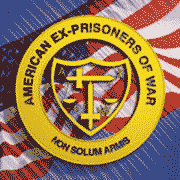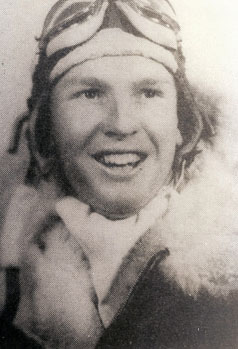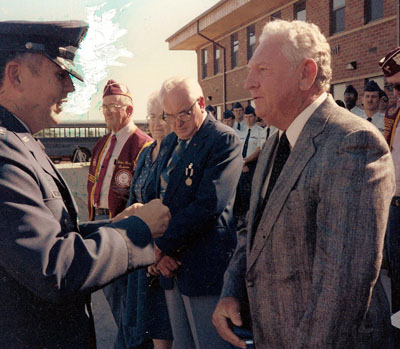
Established April 14, 1942
 |
American Ex-Prisoners of War
A not-for-profit, Congressionally-chartered veterans’ service organization advocating for former prisoners of war and their families.
Established April 14, 1942 |
 |
 |
|
| Last Name | First Name, Middle Init. | Nickname |
| Spouse | City | State, Zip |
| Conflict — Theatre | Branch of Service | Unit: |
| Military Job | Date Captured | Where Captured |
| Age at Capture | Time Interned | Camps |
| Date Liberated | Medals Received | |
| After the War ... | ||
On April 29, 1944, while bombing Naval Installations in Toulon, France, our B-24 encountered heavy "flak" which knocked out two engines. A short time later the third engine started running away and we were forced to ditch in the Mediterranean Sea, about seventy-five (75) miles off the French Coast.
I was in the tail turret when our pilot, O.J. Anderson, gave the order "prepare for ditching". I moved to the waist gun area to help crank up the Ball Turret Gunner, Cpl. Bill Hernhauser, prior to taking my ditching position along with other members of the crew.
When we crashed, I was thrown forward and knocked unconscious; shortly afterwards, I found myself underwater, total confused and entangled in the wreckage. Fortunately, my head popped to the surface near the waist window where I swam out and inflated my "Mae West". The plane was still floating at this time and the first person that I came in contact with was the Radio Operator, Sgt. Fred Beck. We crawled on top of the wing and tripped the levers that released the two five-man rafts that the B-24 was equipped with. The Navigator, Lt. Preston McKart, was seriously injured and had to be lifted into one of the rafts. All ten crewmembers managed to board the rafts prior to the sinking of the plane.
We were without food and water, drifting in the Mediterranean Sea. "Mac" appeared to have a broken back, probably caused by the weight of the Martin Upper Turret falling on him during the crash -- his ditching position was beneath the upper turret, which weighed several hundred pounds. Without medical knowledge, and very limited resources, we were unable to properly comfort "Mac".
After about two days at sea, "Mac" died and, not knowing how long we would be drifting, or whether any of us would survive, the unanimous decision was made to bury "Mac" at sea. This was a most traumatic undertaking, but with prayer book in hand, nine laymen, floating in a tranquil Mediterranean Sea, paid their last respects to a dear friend.
On the third day of our ordeal, we spotted a German FW-190 and sent up some red flares. The German pilot signaled in Morse code, with a flashing device, that he would send help. Several hours later, a large German amphibious aircraft appeared and shuttled the remainder of our crew back to the Toulon-Marseille area. The aircraft had aboard a German doctor, a pilot and an engineer.
On May 3, 1944, Cpl. Bill Gernhauser and I were separated from the other members of the crew and placed in a German controlled hospital in Toulon. Some time later I learned that our pilot 2nd Lt Oscar J "Andy" Anderson, Lincoln, Nebraska; copilot 2nd Lt William A Clancy, Pittsburgh, Pennsylvania; and bombardier 2nd Lt Frank L Wetzel, Cedar Rapids, Iowa, were sent to Stalag Luft 3 in Sagan. Engineer Edmond A Fretz, Jr., Houston, Texas; radio operator Sgt. Fred G. Beck, LaCrosse, Wisconsin; assistant engineer Rocco J. Scavetta, Wildwood, New Jersey; and Cpl Leon Rosenband, Brooklyn, New York, were sent to Stalag Luft IV in Grosstychow, northeast of Berlin. Bill and I were in the same room lying side by side, in two different hospital beds; a German guard was in the room at all times. I had a facial cut from the top of my head to my nose; Bill had a badly injured leg. We each had a chalkboard above our heads, which had an arrow that pointed up or down, which indicated your freedom to be up or down. After a few days my arrow was pointed up which indicated that I was able to move about the hospital so long as the guard was with me. The arrow on Bill's bed never pointed up while I was with him.
About May 16, 1944, I was placed on a passenger train in a plush compartment with three well-uniformed German Officers, for a short ride to Paris. I was dressed in my blue, electrically heated suit with the electrical plug-in cord still attached. We always referred to these suits as "little blue bunny suits". During the trip I was directed by the officers to "do a little dance" while singing "I will be down to get you in a taxi honey, better be ready about half past eight, now honey, don't be late ...." I probably looked like a monkey on a string. Thankfully this was only a short trip and there was no physical abuse. I underwent a thorough examination in Paris at a German-controlled hospital.
About May 18 or 19, 1944, I was placed in an overcrowded (40x8) boxcar with many other American POWs for a trip to the German Interrogation Center in Frankfurt, Germany. I spent three days in solitary confinement while giving my name, rank and serial number each day. My interrogator seemed to know more about me than I knew myself; he informed me that I was a "terror flier" flying out of Italy in a bomber that had its tail painted white, and we were known as "whitetails". Three days later I became a member of a large group of American POWs preparing to be shipped out.
On May 21-22, 1944, I was forced to enter another overcrowded boxcar in Frankfurt to be transported to the train station at Keifheide in Eastern Pommerania, which was northeast of Berlin. We fast marched up the road to Grosstychow and Stalag Luft IV, where we were intimidated by "Big Stoop", interrogated and deloused. I saw no physical violence on our fast march, although I did see "Big Stoop" confiscate pictures from companions of mine and rub them on his private parts while grinning like an ape. I learned later that these were pictures of wives and girlfriends of the POWs.
I was placed in Room #2, Barracks #2, Lager B of Stalag Luft IV; it was now the latter part of May, 1944 (prior to the well-documented "Heydekrug Run Up The Road" which was in July of 1944). I chose an upper bunk and Joseph F. Smith, from Upper Darby, Pennsylvania took the lower bunk. The names of other prisoners in the room that I remember were Bob Hockman, Bisbee, Arizona; Nathan "Jack" Holt, Henderson, Texas; Edward Muszynski, East Chicago, Indiana; John Hawpe, Fort Worth, Texas; Bill Thornhill, Throckmorton, Texas; Roy Littlejohn, Gadsden, Alabama; Dewey Brawley, Arizona; Tommy Griffith, Hungington, West Virginia; J.F. McCasky, Holidays Cove, West Virginia; Roy Jones, Palestine, Texas; R.F. Temple, Dallas, Texas, Ed D. Roser; Timothy O'Brian; Jim Rogers; Oscar C. Rogers; Ray Hellstrom; and Dan South, Clyde, Texas, who came to Stalag Luft IV in November, 1944. (Dan is a retired Postmaster and presently lives in Clyde, Texas; we visit by telephone about once per week.)
I was given the name "Buck" after "Buck Benny rides again" and remember well several things that happened during my eight month stay in Luft IV: the fellow Kriegie being shot by a German guard while sitting in a barracks window; the British prisoners being struck by lightening while living in the "hutments" that had been built in the center of Lager B; the electrocuted German hanging from a power pole on the perimeter of the compound; and especially the singing of Christmas Carols on Christmas Eve, 1944.
Early in February 1945, the Russian Army was advancing from the East and we were told to prepare to evacuate. On February 5, 1945, the men of Lager B were moved into Lager C. As luck would have it, I discovered that Arthur Montgomery, a classmate of mine (1940) from San Angelo Central High School, Texas, had been shot down and was living in Lager C. "Monte" Montgomery found a space for me to sleep near his bunk, in Lager C.
On February 6, 1945, we packed up and moved out, first stopping in the Vorlager to pick up as many Red Cross parcels as we could carry; regretfully many of these were dropped along the wayside. This was the beginning of the well-documented eighty-six day "Death March" as described by then Capt. Leslie Caplan, Flight Surgeon, US Army Air Corps. The horrors of the march may be found in many true accounts in publications and stories on the Internet.
It did not take long -- while marching in bitter cold wet weather without proper food and water, sleeping in barns and on open ground -- for fatigue, malnutrition, dysentery and disease to set in. I was marching with Joseph F. Smith, my bunkmate in Luft IV, and Leon "Rosie" Rosenband, a member of my bomber crew. I remember well Rosie giving me a pair of dry socks since my feet were "soaked to the bone". This was Christmas in February. Sometime later I became ill with influenza-like symptoms and could no longer march. I was lying in a barn somewhere in Germany.
By now it must have been late February or early March, and, although my high temperature clouded my memory somewhat, I remember this person visiting with me -- I don't recall whether or not he said his name was Capt. Leslie Caplan or Dr. Leslie Caplan -- I do recall that he thought I had diphtheria and he would send help. I do definitely remember that when he left, I found a can of tuna from a Red Cross parcel beneath my blanket.
Due to my illness, my memory lessened and I lost track of time. I recall that it was early March and I was feeling well enough walk a little. Joe Smith directed me to the barn where Capt. Caplan was and I joined the "slow party." I never saw Leon Rosenband again. I think Joe was working with Capt. Caplan because I kept seeing Joe and talking to him.
Sometime in March, I think I was riding in a wagon being pulled by Capt. Caplan's dedicated crew. We arrived at Stalag XIB, in Fallingbostel, Germany. I recall that this German captain was trying to put the "slow party" inside. Capt. Caplan paid a visit to the camp and when he returned he informed everyone that the prisoners inside were starving and dying of disease. Capt. Caplan stated, in no uncertain terms, that we were moving on, which we did. Although I was with Capt. Caplain's "slow party", I did not see him often. This was now early in April and there were several hundred POWs from Luft IV camped out or living in barns along the marching route. I understood that Capt. Caplan was spending all of his waking hours walking up and down the "marching column" trying to care for the ill POWs. By this time, he had several dedicated people working diligently with him.
Fallingbostel became the turning point for the march from Luft IV. It was early in April 1945, and everyone on the march -- that was able -- began to move in an easterly direction which was in reverse to the direction that the march had begun. I became ambulatory again -- because of the "beyond the call of duty" excellent care provided by Capt. Caplan and his crew -- and joined up again with Joseph F. Smith, from Upper Darby, PA, my former bunkmate in Luft IV.
Joe and I awoke one morning, near Luneburg, Germany, and found that the marching column had no German guards. Joe and I walked away from the group and slept in an old barn. The next day we met up with three British POWs that had been prisoners since Dunkirk. The next morning we heard small rifle fire and one of the British guys took off to investigate. He came back, all excited, while describing a small, olive-colored army vehicle that he had never seen before -- this turned out to be a US army jeep. We had been overrun by the British 11th Armored Division who shuttled us back to Celle, Germany, where we boarded a British Lancaster for a flight to London. I have a V-mail letter written by me on April 19, 1945, and sent to my mother from an American Hospital in Bicester, England. I also have a telegram from the US Government to my mother, which stated that I was returned to Military Control on April 22, 1945. After several days' recuperation in the hospital at Bicester, I was transferred to a RAMP (Recovered Allied Military Personnel) Unit in London.
About May 19, 1945, I boarded the ship Kungsholm in Southampton, England, for the return trip to New York City, NY. On May 28, 1945, the Kungsholm passed the Statue of Liberty and docked in New York. I spent a few days in Camp Shanks, NY where German prisoners were serving the American ex-prisoners of war. I boarded a train bound for San Antonio, Texas, by way of Fort Worth, Texas. On June 2, 1945, I took a bus to Austin, Texas, where my brother Wade Beesley was a student at the University of Texas. Wade, now discharged, had been Lt. Wade H. Beesley, a bombardier on a B-17 Flying Fortress. He was seriously injured in a plane crash in Sarasota, Florida on May 9, 1942.
June 2, 1945, the day I arrived in Austin, was the second birthday of Wade's daughter, Sandy, my niece. On June 3, Wade drove me to Fredricksburg, Texas, where I was picked up by my mother, Hazel Beesley, along with Jean Stepp and Elsie Goehme Delaney. I arrived in San Angelo, Texas, on the evening of June 3, 1945. For me the war was truly over.
-Stratton W. Beesley, Sr.